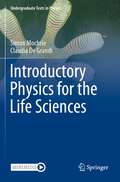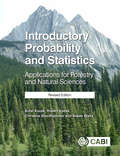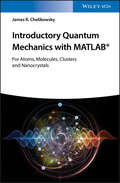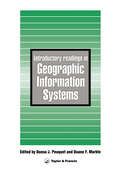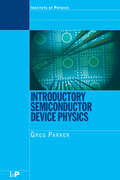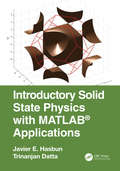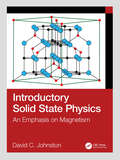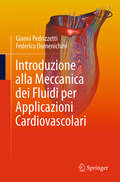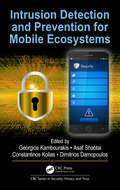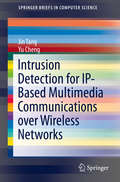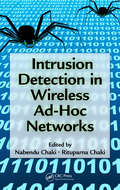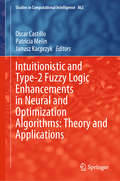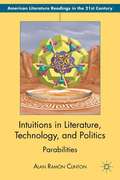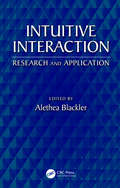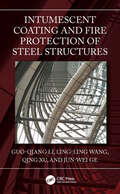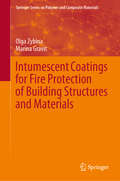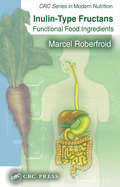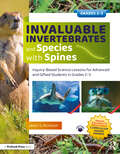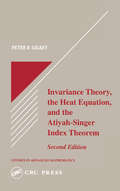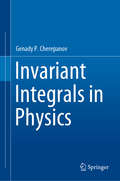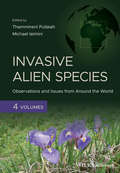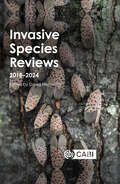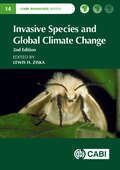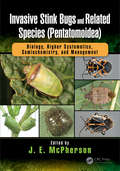- Table View
- List View
Introductory Physics for the Life Sciences (Undergraduate Texts in Physics)
by Simon Mochrie Claudia De GrandiThis classroom-tested textbook is an innovative, comprehensive, and forward-looking introductory undergraduate physics course. While it clearly explains physical principles and equips the student with a full range of quantitative tools and methods, the material is firmly grounded in biological relevance and is brought to life with plenty of biological examples throughout.It is designed to be a self-contained text for a two-semester sequence of introductory physics for biology and premedical students, covering kinematics and Newton’s laws, energy, probability, diffusion, rates of change, statistical mechanics, fluids, vibrations, waves, electromagnetism, and optics. Each chapter begins with learning goals, and concludes with a summary of core competencies, allowing for seamless incorporation into the classroom. In addition, each chapter is replete with a wide selection of creative and often surprising examples, activities, computational tasks, and exercises, many of which are inspired by current research topics, making cutting-edge biological physics accessible to the student.
Introductory Probability and Statistics: Applications for Forestry and Natural Sciences (Revised Edition)
by Robert Kozak Antal Kozak Christina Staudhammer Susan WattsAll students, practitioners and researchers in forestry and related disciplines need a good grounding in statistics and probability. This need is increasing as techniques for gathering and analysing large amounts of data are becoming commonplace. This revised edition of this unique textbook is specifically designed for statistics and probability courses taught to students of forestry and related disciplines. It introduces probability, statistical techniques, data analysis, hypothesis testing, experimental design, sampling methods, nonparametric tests and statistical quality control, using examples drawn from a forestry, wood science and conservation context. The book now includes several new practical exercises for students to practice data analysis and experimental design themselves. It has been updated throughout, and its scope has been broadened to reflect the evolving and dynamic nature of forestry, bringing in examples from conservation science, recreation and urban forestry. - Specifically written and designed to teach statistics and probability to students of forestry and related disciplines in the natural sciences - This revised edition has been broadened to reflect the dynamism of modern forestry -Chapters in this revised edition include new practical exercises allowing students to practice data analysis and experimental design
Introductory Quantum Mechanics with MATLAB: For Atoms, Molecules, Clusters, and Nanocrystals
by James R. ChelikowskyPresents a unique approach to grasping the concepts of quantum theory with a focus on atoms, clusters, and crystals Quantum theory of atoms and molecules is vitally important in molecular physics, materials science, nanoscience, solid state physics and many related fields. Introductory Quantum Mechanics with MATLAB is designed to be an accessible guide to quantum theory and its applications. The textbook uses the popular MATLAB programming language for the analytical and numerical solution of quantum mechanical problems, with a particular focus on clusters and assemblies of atoms. The textbook is written by a noted researcher and expert on the topic who introduces density functional theory, variational calculus and other practice-proven methods for the solution of quantum-mechanical problems. This important guide: -Presents the material in a didactical manner to help students grasp the concepts and applications of quantum theory -Covers a wealth of cutting-edge topics such as clusters, nanocrystals, transitions and organic molecules -Offers MATLAB codes to solve real-life quantum mechanical problems Written for master's and PhD students in physics, chemistry, material science, and engineering sciences, Introductory Quantum Mechanics with MATLAB contains an accessible approach to understanding the concepts of quantum theory applied to atoms, clusters, and crystals.
Introductory Readings In Geographic Information Systems
by Donna J. Peuquet Duane F. MarbleEven though Geographic Information Systems GIS have been available for over 20 years, they have only recently become accessible to geographers and others as a useful tool in spacial analysis. This book assembles a balanced sample of written works covering important aspects of the basic principles of GIS and selected examples of applications.
Introductory Semiconductor Device Physics
by Greg ParkerIntroduction to Semiconductor Device Physics is a popular and established text that offers a thorough introduction to the underlying physics of semiconductor devices. It begins with a review of basic solid state physics, then goes on to describe the properties of semiconductors including energy bands, the concept of effective mass, carrier concentr
Introductory Solid State Physics with MATLAB Applications
by Javier E. Hasbun Trinanjan DattaSolid state physics, the study and prediction of the fundamental physical properties of materials, forms the backbone of modern materials science and has many technological applications. The unique feature of this text is the MATLAB®-based computational approach with several numerical techniques and simulation methods included. This is highly effective in addressing the need for visualization and a direct hands-on approach in learning the theoretical concepts of solid state physics. The code is freely available to all textbook users. Additional Features: Uses the pedagogical tools of computational physics that have become important in enhancing physics teaching of advanced subjects such as solid state physics Adds visualization and simulation to the subject in a way that enables students to participate actively in a hand-on approach Covers the basic concepts of solid state physics and provides students with a deeper understanding of the subject matter Provides unique example exercises throughout the text Obtains mathematical analytical solutions Carries out illustrations of important formulae results using programming scripts that students can run on their own and reproduce graphs and/or simulations Helps students visualize solid state processes and apply certain numerical techniques using MATLAB®, making the process of learning solid state physics much more effective Reinforces the examples discussed within the chapters through the use of end-of-chapter exercises Includes simple analytical and numerical examples to more challenging ones, as well as computational problems with the opportunity to run codes, create new ones, or modify existing ones to solve problems or reproduce certain results
Introductory Solid State Physics: An Emphasis on Magnetism
by David C. JohnstonIntroductory Solid State Physics: An Emphasis on Magnetism acts as a supplement to students tackling solid state physics at both the undergraduate and graduate level. The BCS theory of superconductivity is not included in undergraduate-level books, because the theory is derived at the graduate level. However, this book uses the equations derived by BCS to calculate the thermodynamic properties of superconductors such as the temperature dependence of the heat capacity using techniques accessible to undergraduates. Also covering topics such as wave diffraction, the essentials of thermodynamics, statistical mechanics and local-moment magnetism, it is useful for those studying solid state physics at any level.Key Features: Includes the BCS theory of superconductivity Provides material that is accessible to students at all levels Approaches the subject with a particular emphasis on magnetism
Introduzione alla Meccanica dei Fluidi per Applicazioni Cardiovascolari
by Gianni Pedrizzetti Federico DomenichiniQuesto libro parte da una descrizione degli elementi fondamentali della meccanica dei fluidi nei grandi vasi sanguigni. A questo fine, viene introdotto un rigoroso background fisico accompagnato da esempi applicati alla circolazione, presentando risultati classici e sviluppi recenti relativi allo studio della dinamica sanguigna nella fisiologia cardiovascolare. Esplora poi argomenti più avanzati per una comprensione dei fenomeni, effettivamente riscontrati in cardiologia clinica, fondata sull’utilizzo delle leggi di conservazione della meccanica. Il testo si presenta come una risorsa di apprendimento ideale per fisici e ingegneri che si occupano di dinamica dei fluidi cardiovascolare, operatori nel settore delle tecnologie biomediche, studenti in biofluidodinamica. Il libro fornisce un filo conduttore tra i campi distanti della meccanica dei fluidi e della cardiologia clinica. Ben radicato nella teoria della dinamica dei fluidi, guida il lettore attraverso scenari progressivamente più realistici fino alla complessità delle applicazioni mediche di routine. Basato su oltre 25 anni di collaborazioni dell'autore con i cardiologi, aiuta gli ingegneri a imparare a comunicare con i clinici, mantenendo al contempo il rigore delle discipline scientifiche. Scritto in uno stile conciso, è un libro di testo accessibile a un ampio pubblico di lettori, tra cui studenti, fisici e ingegneri, offrendo un punto di ingresso a questo campo multidisciplinare. Include concetti chiave esemplificati da illustrazioni che utilizzano tecniche di analisi di immagini all'avanguardia e da riferimenti a metodi di modellazione e misurazione, e contiene intuizioni originali uniche.
Intrusion Detection and Prevention for Mobile Ecosystems (Series in Security, Privacy and Trust)
by Georgios Kambourakis, Asaf Shabtai, Constantinos Kolias and Dimitrios DamopoulosThis book presents state-of-the-art contributions from both scientists and practitioners working in intrusion detection and prevention for mobile networks, services, and devices. It covers fundamental theory, techniques, applications, as well as practical experiences concerning intrusion detection and prevention for the mobile ecosystem. It also includes surveys, simulations, practical results and case studies.
Intrusion Detection for IP-Based Multimedia Communications over Wireless Networks
by Jin Tang Yu ChengIP-based multimedia communications have become increasingly popular in recent years. With the increasing coverage of the IEEE 802:11(tm) based wireless networks, IP-based multimedia communications over wireless networks are also drawing extensive attention in both academia and industry. Due to the openness and distributed nature of the protocols involved, such as the session initiation protocol (SIP) and the IEEE 802:11(tm) standard, it becomes easy for malicious users in the network to achieve their own gain or disrupt the service by deviating from the normal protocol behaviors This SpringerBrief presents real-time intrusion detection techniques that can quickly track the malicious behaviors which manipulate the vulnerabilities from either the 802. 11(tm) or the SIP protocols. More specifically, this book presents interdisciplinary techniques to achieve an effective real-time intrusion detection system, which interweaves medium access control (MAC) protocol analysis, cumulative sum (CUSUM) based detector design, a novel Markovian model for CUSUM detectors, sketch-based traffic modeling, and wavelet based signal processing techniques.
Intrusion Detection in Wireless Ad-Hoc Networks
by Nabendu Chaki Rituparna ChakiPresenting cutting-edge research, Intrusion Detection in Wireless Ad-Hoc Networks explores the security aspects of the basic categories of wireless ad-hoc networks and related application areas. Focusing on intrusion detection systems (IDSs), it explains how to establish security solutions for the range of wireless networks, including mobile ad-hoc
Intuitionistic and Type-2 Fuzzy Logic Enhancements in Neural and Optimization Algorithms: Theory and Applications (Studies in Computational Intelligence #862)
by Oscar Castillo Patricia Melin Janusz KacprzykThis book describes the latest advances in fuzzy logic, neural networks, and optimization algorithms, as well as their hybrid intelligent combinations, and their applications in the areas such as intelligent control, robotics, pattern recognition, medical diagnosis, time series prediction, and optimization. The topic is highly relevant as most current intelligent systems and devices use some form of intelligent feature to enhance their performance. The book also presents new and advanced models and algorithms of type-2 fuzzy logic and intuitionistic fuzzy systems, which are of great interest to researchers in these areas. Further, it proposes novel, nature-inspired optimization algorithms and innovative neural models. Featuring contributions on theoretical aspects as well as applications, the book appeals to a wide audience.
Intuitions in Literature, Technology, and Politics: Parabilities (American Literature Readings in the 21st Century)
by Alan Ramón ClintonUsing the idea of 'parability,'or the ability for writers to tell improper stories, as a foundation, Alan Ramón Clinton synthesizes a new model for a creative, more daring literary criticism. Sharp and surprising, this wide-ranging project engages with the work of Pynchon, Eco, Forché, Merrill, Weiner, Plath, Ashbery, and Eigner.
Intuitive Interaction: Research and Application
by Alethea BlacklerThis book explores recent research in intuitive interaction worldwide by a range of leading academics and practitioners in the field. It builds on past work as it ventures into new areas, such as how users perceive intuitiveness of an interface, how people experience intuitive interaction subjectively, and how we can use such understanding to design more engaging experiences. The book addresses how intuitive interaction is understood in different academic disciplines and how it has been researched in various parts of the world over the last 18 years. It covers how intuitive interaction can be applied in different contexts, like large scale urban installations, the developing world, in older populations, and in various industry applications. <P><P>Features: <li>Presents varied approaches to intuitive interaction research and application <li>Illustrates how to understand and apply intuitive interaction to interfaces <li>Provides a mix of academic and industry perspectives <li>Explores a variety of contexts for application of intuitive interaction <li>Encompasses design, IT, business, and psychological approaches
Intumescent Coating and Fire Protection of Steel Structures
by Qing Xu Guo-Qiang Li Ling-Ling Wang Jun-Wei GeIntumescent Coating and Fire Protection of Steel Structures establishes the thermo insulation characteristics of intumescent coating under various fire and hydrothermal aging circumstances and shows how to predict the temperature elevation of steel structures protected with intumescent coatings in fires for avoiding structural damage. Introduced are the features and applications of intumescent coatings for protecting steel structures against fire. The constant effective thermal conductivity is defined and employed to simplify the quantification for the thermo-resistance of intumescent coatings. An experimental investigation into the hydrothermal aging effects on insulative properties of intumescent coatings is presented, as well as the influence of topcoat on insulation and aging of intumescent coatings. Also described is a practical method for calculating the temperature of the protected steel structures with intumescent coatings in order to evaluate the fire safety of a structure. The book is aimed at fire and structural engineers, as well as researchers and students concerned with the protection of steel structures.
Intumescent Coatings for Fire Protection of Building Structures and Materials (Springer Series on Polymer and Composite Materials)
by Olga Zybina Marina GravitThe book provides practical recommendations for creation of fire retardant materials with an increased service life. The enhanced fire resistance seen in these materials is based on the regularities of the chemical and physicochemical interaction of the components of intumescent composition in the process of thermolytic synthesis of heat-insulating char-foamed layers. The aim of fire protection of various objects with intumescent materials is to create a heat-insulating charred layer on the surface of structural elements; this layer can withstand high temperatures and mechanical damage which are typical during fires. The authors describe the contribution of basic components (melamine, pentaerythritol, ammonium polyphosphate), additional components (chlorinated paraffin, urea, cellulose, carbon nano additives, etc.) and polymer binders of intumescent compositions on the process of charring. The technological aspects of manufacturing, application and operation of fire retardant intumescent compositions, which can be useful for organizations that produce and use fire retardant materials, are also described.
Inulin for Pharmaceutical Applications: A Versatile Biopolymer
by Neeraj Mishra Wasim Akram Tanweer HaiderThis book explores the different uses of inulin in pharmaceutical formulations, its potential therapeutic benefits, and the regulatory considerations involved in developing inulin-based pharmaceutical products. The book covers topics such as the physical and chemical properties of inulin, its use in drug delivery and controlled release systems, therapeutic applications in managing metabolic disorders, gastrointestinal disorders, immune function, bone health, and brain health, as well as the regulatory considerations involved in developing inulin-based pharmaceutical products. The book aims to provide a complete understanding of the various applications of inulin in the pharmaceutical industry, making it relevant and significant for pharmaceutical professionals seeking to develop new drugs and drug delivery systems. Additionally, it provides valuable information for researchers and scientists working on inulin-based treatments and formulations. It appears to be a comprehensive guide for scientists, researchers, and pharmaceutical professionals interested in understanding the various applications of inulin in the pharmaceutical industry.
Inulin-Type Fructans: Functional Food Ingredients (Modern Nutrition)
by Marcel RoberfroidInulin and oligofructose are naturally occurring resistant carbohydrates that have a variety of uses as functional food ingredients. In addition to their role as prebiotics that selectively stimulate the growth of beneficial bacteria in the intestines, these inulin-type fructans act as dietary fiber in the digestive system and have applications as
Invaluable Invertebrates and Species with Spines: Inquiry-Based Science Lessons for Advanced and Gifted Students in Grades 2-3
by Jason S. McIntoshRecipient of the 2022 NAGC Curriculum AwardInspire the next generation of zoologists with this 30-lesson interdisciplinary science unit geared toward second and third grade high-ability students.Using problem-based learning scenarios, this book helps students develop the vocabulary, skills, and practices of zoologists as they conduct research and solve real world problems. Students will gain an in-depth understanding of how the animal kingdom is structured, create an innovative zoo exhibit containing an entire ecosystem for a vertebrate animal of their choosing, design invertebrate animal trading cards, and much, much more. Featuring detailed teacher instructions and reproducible handouts, this unit makes it easy for teachers to adjust the rigor of learning tasks based on students’ interests and needs.Aligned with Common Core State Standards for English Language Arts and Mathematics plus the Next Generation Science Standards, gifted and non-gifted teachers alike will find this expedition into the animal kingdom engaging, effective, and highly adaptable.
Invariance Theory: The Heat Equation and the Atiyah-Singer Index Theorem (Studies in Advanced Mathematics #16)
by Peter B. GilkeyThis book treats the Atiyah-Singer index theorem using the heat equation, which gives a local formula for the index of any elliptic complex. Heat equation methods are also used to discuss Lefschetz fixed point formulas, the Gauss-Bonnet theorem for a manifold with smooth boundary, and the geometrical theorem for a manifold with smooth boundary. The author uses invariance theory to identify the integrand of the index theorem for classical elliptic complexes with the invariants of the heat equation.
Invariant Integrals in Physics
by Genady P. CherepanovIn this book, all physical laws are derived from a small number of invariant integrals which express the conservation of energy, mass, or momentum. This new approach allows us to unify the laws of theoretical physics, to simplify their derivation, and to discover some novel or more universal laws. Newton's Law of gravity is generalized to take into account cosmic forces of repulsion, Archimedes' principle of buoyancy is modified for account of the surface tension, and Coulomb's Laws for rolling friction and for the interaction of electric charges are substantially repaired and generalized. For postgraduate students, lecturers and researchers.
Invasive Alien Species: Observations and Issues from Around the World
by T. Pullaiah Michael R. IelminiInvasive alien species are spreading into new ecosystems each year. The impacts caused by these invaders can be swift and devastating. The topic of invasive alien species is large, complex, and globally significant at various scales, exacerbated by the globalization of world economies and increased trade and commerce that has overcome natural barriers to species movement. Invasive alien species threaten global food supplies, water quality and availability, and energy production and delivery. With the added risks associated with global climate change, the global homogenization of plants, animals, and microbes is a major factor in the decline in ecosystem health and ecosystem services worldwide. To counter this trend, there is a critical need to unify governments, cultures, and programs to improve cross-boundary coordination to effectively address the wide range of invasive alien species threats to the environment, economies, and to plant and animal health; particularly human health. This 4-volume work is the first to compile a set of useful material for key topics, to provide a better understanding of the overall global threat of invasive alien species and the diverse array of problems faced around the world, and assemble material that includes potential replicable solutions to overcome these threats. The books also highlight the threat posed by invasive alien species in terms of a global ‘call to action’. Since invasive species know no boundaries, it is our hope that by compiling material from different scientific and social perspectives around the world, and sharing knowledge and examples of a diverse array of associated topics, we can advance global awareness and improve unified national responses to the threat posed by invasive alien species.
Invasive Species Reviews: 2018-2024
by David HemmingInvasive species are responsible for significant impacts on agriculture, food security and health worldwide. This collection looks at a wide range of invasive species, including insects, plants, snails, fungal diseases, including: Mimosa diplotricha, Chromolaena odorata, privet, Opuntia, fall armyworm, Aedes albopictus, Prostephanus truncatus, Pomacea, and ash dieback. The articles examine mechanisms for detecting the spread of invasive species, and models for understanding the mechanisms of invasion alongside control and management approaches with a particular focus on biological control. The articles have been specially selected from contributions to CABI Reviews.
Invasive Species and Global Climate Change (CABI Invasives Series)
by Lewis H. ZiskaThis book addresses topics related to the impact of invasive species including biosecurity, demographics, species diversity and food security. It is meant for researchers, upper-level students, and policy makers and provides a factual basis for the underlying science and a discussion of that information with respect to current and future impacts and possible solutions. This book explores the nexus of climate change and biological invasions, resulting impacts (biological and economic) and assesses ways to reduce vulnerability and increase the resiliency and sustainability of managed and unmanaged ecosystems. The book has three parts, focusing on: (1) the dimensions of the problem; background and science; (2) case studies; (3) Management: detection, prevention, control and adaptation. This revised edition examines a wide range of topics and region, the underlying science, examples (case studies) from around the world, and ways and means to recognize, manage and control the consequences. It includes new cases and new threats; for example, a chapter summarizing case studies regarding climate change and invasive species that are also disease carriers (e.g. ticks and Lyme disease). - Covers a wide range of topics and areas - Examines the synergy between invasive species and climate change - Explains options to control and mitigate effects This book is of interest to academics, researchers and students studying climate change and invasive species. Those interested in the environment and ecology, land managers, policy makers, agronomists, federal and state departments of natural resources, climate change activists, public health professionals.
Invasive Stink Bugs and Related Species: Biology, Higher Systematics, Semiochemistry, and Management (Contemporary Topics in Entomology)
by J. E. McPhersonKey features: Presents a brief history of past classifications, a summary of present classification, and speculation on how the classification may evolve in the future Includes keys for the identification of families and subfamilies of the Pentatomoidea and for the tribes in the Pentatomidae Explains transmission of plant pathogens and concepts of pathology and heteropteran feeding for the non-specialist Provides an extensive literature review of transmission by stink bugs of viral, bacterial, fungal, and protozoan organisms that cause diseases of plants Discusses the diversity of microbial symbionts in the Pentatomidae and related species, showing how microorganisms underpin the evolution of this insect group Reviews semiochemicals (pheromones, kairomones, allomones) of the Pentatomoidea and their vital role in the life histories of pest and beneficial species and their exploitation by natural enemies of true bugs Covers past, current, and future control options for insects, with a focus on stink bugs and related heteropterans The Superfamily Pentatomoidea (stink bugs and their relatives) is comprised of 18 families with over 8,000 species, the largest of which is the family Pentatomidae (about 5,000 species). These species primarily are phytophagous, and many cause tremendous economic damage to crops worldwide. Within this superfamily are six invasive species, two that occur worldwide and four that are recent invaders in North America. Once established in new geographic regions, these species have increased their numbers and geographic distributions dramatically, causing economic damage totaling billions of dollars. Invasive Stink Bugs and Related Species (Pentatomoidea): Biology, Higher Systematics, Semiochemistry, and Management is the first book that presents comprehensive coverage of the biology of invasive pentatomoids and related true bug species and addresses issues of rapidly growing economic and environmental concerns. Containing the contributions of more than 60 stink bug specialists from 15 countries, this book provides a better understanding of the biology and economic importance of these invasive species, why they became invasive, and how their continued geographical expansion is likely to affect numerous agricultural systems and natural environments. Including over 3,500 references, this authoritative work serves as an access point to the primary literature on their life histories, higher systematics, diapause and seasonal cycles, pathogens, symbionts, semiochemistry, and pest management control strategies for pentatomoid bugs.
